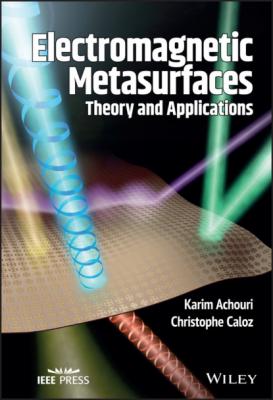Electromagnetic Metasurfaces. Christophe Caloz
Читать онлайн.| Название | Electromagnetic Metasurfaces |
|---|---|
| Автор произведения | Christophe Caloz |
| Жанр | Физика |
| Серия | |
| Издательство | Физика |
| Год выпуска | 0 |
| isbn | 9781119525172 |
For electrically small particles, we may use the Clausius–Mosotti expression, which relates the local field to the total electric,
(2.21)
where
(2.22)
where
(2.23)
where
An important particular case of the Lorentz model (2.23) is the Drude model, which applies to metals. In a metal, the electrons are free charge carriers, which implies that the restoring force (2.16) is zero, leading to
The plasma frequency and damping of aluminum, gold, and silver, which are metals frequently used in the optical regime, are reported in Table 2.1. As the frequency increases and approaches the plasma frequency, these metals behave more and more as lossy dielectrics. In contrast, in the microwave regime, metals behave as perfect electric conductors (PEC), with negligible dispersion. This is of particular importance for the practical realization of metallic-based metasurfaces, especially in the optical regime where the lossy nature of these metals becomes substantial.
To further illustrate the dispersive behavior of these metals, Figure 2.3 plots the real and imaginary parts of their permittivity in the optical regime. At the longer wavelengths, they behave as expected, i.e. they exhibit a permittivity with large negative real and imaginary parts. However, as the wavelength tends toward the plasma frequency, their optical behavior changes: they become less opaque and thus let light penetrate deeper in them.
Figure 2.2 Dispersive response of the electric susceptibility of a resonant structure for the parameter
Table 2.1 Plasma frequency
| Metal |
Plasma frequency, |
Damping, |
|---|---|---|
| Ag | 9.013 (137.56 nm) | 0.018 |
